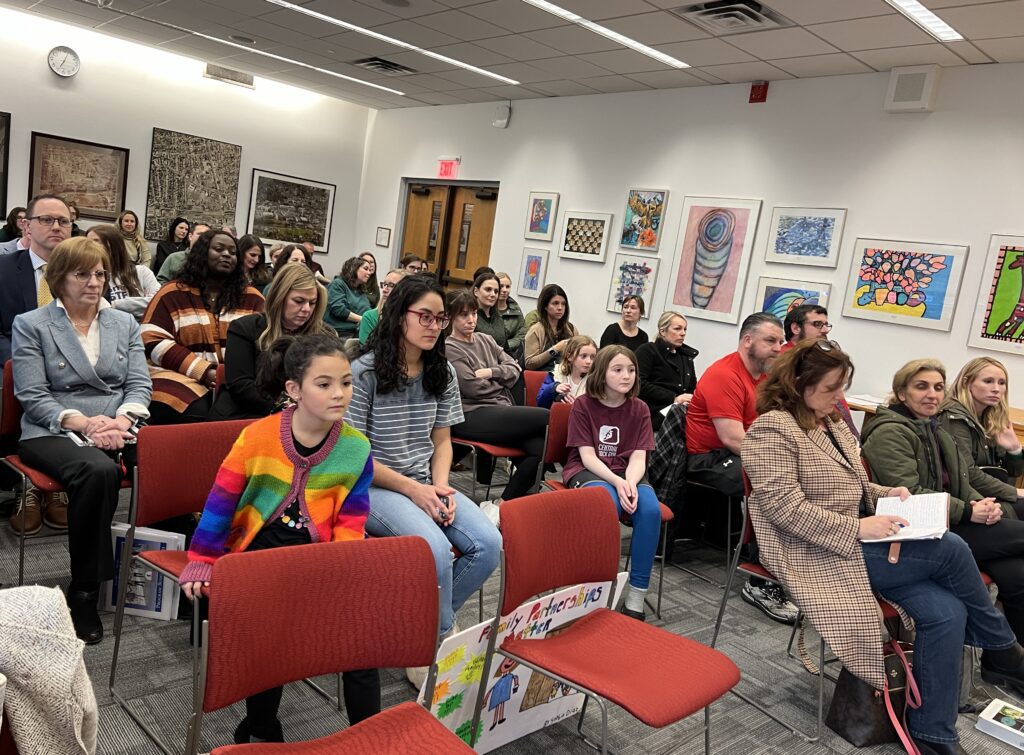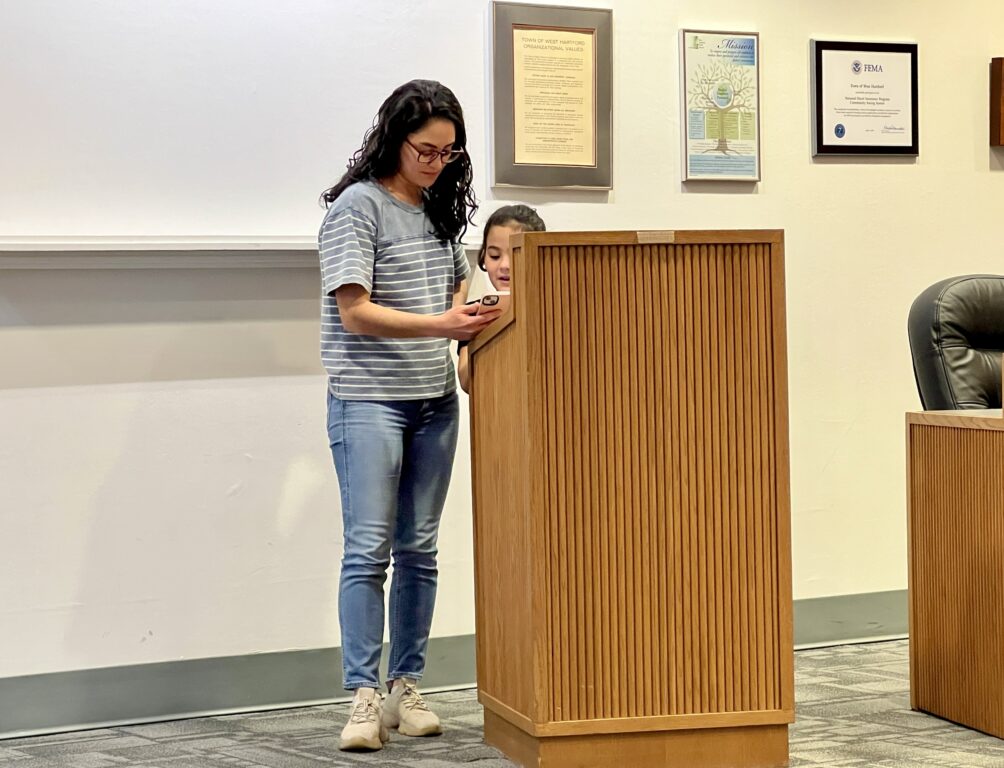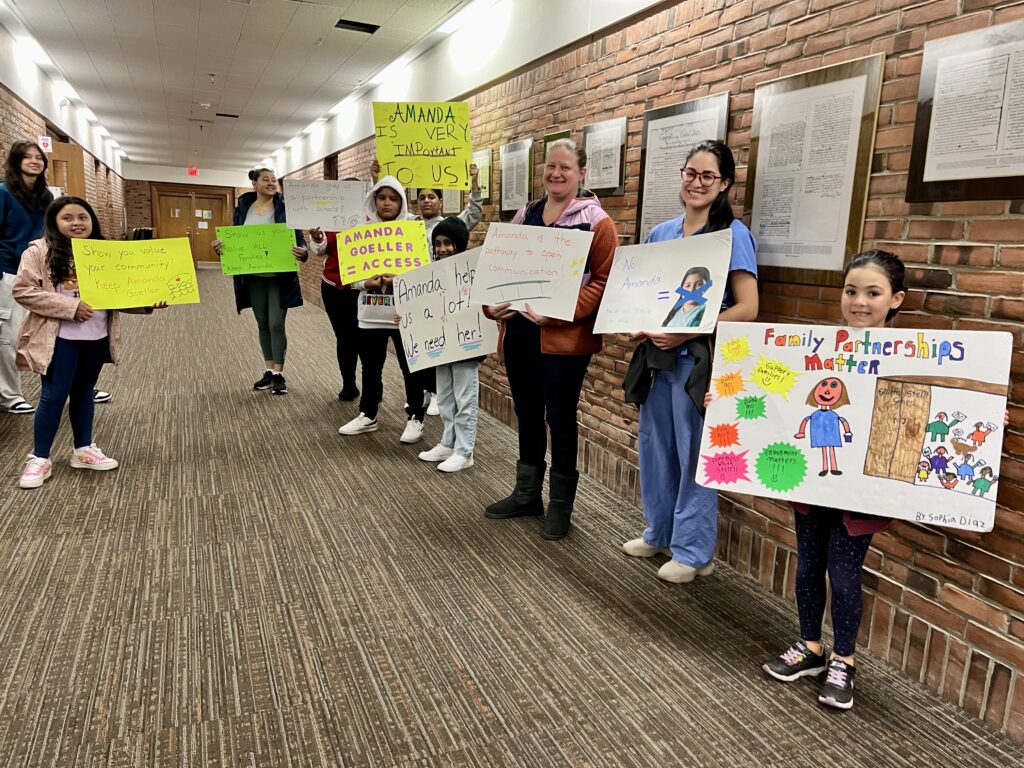West Hartford Board of Education Adds Back Some Jobs, Approves 2024-2025 Budget

Audio By Carbonatix

Director of Finance and Planning Liz Hewitt updates a spreadsheet as the Board of Education votes on amendments, and then the entire West Hartford Public Schools budget. Photo credit: Ronni Newton
The West Hartford Board of Education made some alterations to the original proposal by Superintendent Paul Vicinus before voting 5-2 to adopt the 2024-2025 budget Thursday night.

A large crowd attended the Board of Education meeting on April 4, budget adoption night. Photo credit: Ronni Newton
By Ronni Newton
The bottom line number didn’t change much, but after extensive discussion that followed an outpouring of comments from the community, the West Hartford Board of Education made some amendments to the initial budget proposal presented March 5 by Superintendent Paul Vicinus. In the end, the role of family and community engagement coordinator – a home-school liaison role for Smith STEM and Charter Oak International Academy currently held by Amanda Goeller – will be maintained and some of the existing elementary school counselors will also be funded, while pay-to-play for high school sports will no longer be subsidized other than for those who qualify for waivers.
The overall $201,359,356 general fund budget for 2024-2025 – which is $55,500 higher than the initial proposal – passed on a party line vote of 5-2. The total spending plan is 5.87% higher than the current budget of $190,191,121.
Before the Board voted on the budget, Vicinus shared some good news and some bad news: the good news is that the renewal of the health insurance plan came in lower than the initial projection of a 5% across-the-board increase. The medical and dental coverage for retirees will increase just 3% and for active employees will increase just 2%, adding back $250,000 that won’t need to be spent on those items.
The bad news from Vicinus, however, is that the state has announced it will only be funding the excess tuition cost for out-of-district placement for students with special needs at 66.7%, rather than the estimate of 68%, creating an additional $132,000 burden for an overall roughly $1.6 million shortfall. The reimbursement is supposed to kick in once tuition costs exceed 4.5 times the district’s per pupil cost, and the state had committed to paying 85% of that excess cost to the districts, but the money is not there in the state fund.
Vicinus said while the cut in the reimbursement percentage affects all 169 municipalities, West Hartford is adversely impacted because many families who have children with special needs chose to live in the district, and although the majority of students are educated in town, West Hartford is hit with the fourth highest dollar impact out of the 169 towns.
The Board voted unanimously to revise the budget to reflect the $250,000 savings due to the adjusted health care premium. And while no one liked the move by the state to cut the reimbursement percentage, and there were calls to lobby legislator about it, there really is no choice at this time but to accept the reimbursement rate and the Board also unanimously voted for that amendment to the original budget as well.
At a public hearing on March 27, roughly two dozen people addressed the Board, with most asking the Board not to eliminate the “family and community engagement coordinator” position for Smith STEM and Charter Oak International Academy, to preserve at least some of the elementary school counselors, and to remedy the large class sizes at Duffy Elementary School. Many more provided their comments via email over the past several weeks advocating for those additions to the budget.
Several of those items were proposed Thursday as amendments to the budget, including Democrat Clare Taylor Neseralla’s motion to reinstate the family and community engagement coordinator/home-school liaison position, adding $85,000 to the budget. “It is very clear that there is huge community support for this role at Smith and Charter Oak,” she said.

Ruby Diaz and daughter, Sophie, speak to the Board of Education on April 4 regarding maintaining the family and community engagement coordinator. Photo credit: Ronni Newton
The position had previously been part-time and funded through a Title III grant, but for the past several years was made full-time and funded through the Elementary and Secondary School Emergency Relief (ESSER) grants given to schools as a result of the COVID-19 pandemic.
The ESSER funds sunset as of June 30, 2024, and the role was among the 40 jobs not initially planned for inclusion in the general fund budget.
“It is clear from the moving testimonials … that this is a position that makes a clear difference in our schools,” and serves the most vulnerable community, said Democrat Jason Gagnon, who seconded the motion.
While noting that he did not want the budget to exceed the 5.8% increase in the original proposal, Republican Ethan Goldman supported the motion to reinstate that position. It passed unanimously, 7-0, and drew applause from the roughly 80 people in the audience.
Grant funding will continue to be pursued, and if received will be used to offset the budgeted amount.

Prior to the Board of Education budget hearing on March 27, residents advocated for keeping the role held by Amanda Goeller. Photo credit: Ronni Newton (we-ha.com file photo)
Democrat Shannon Marimón, the Board vice chair, proposed restoring three of the five elementary school counselors that had been funded through ESSER, acknowledging that the excess cost of three additional positions would push the budget slightly above Vicinus’ original proposal, but would be “ensuring coverage without overwhelming the budget at this time.”
The cost of adding three FTE positions for the counsellors totals $306,000 – $102,000 each for salary and benefits, said Liz Hewitt, the director of Finance and Planning. Marimón said it’s an important need “to proactively get ahead of issues that are arising” with disregulation of behavior among students, and to go from five counselors to none would increase the case load for school social workers and psychologists to a level that would be unsustainable. “Investment in these positions – I see a huge return,” Marimón said.
“It’s going to be very hard for me to vote to increase the budget by that amount of money,” Republican Gayle Harris said, asking Marimón if she would consider fewer than three counselors. Marimón did not want to further reduce the number, noting that perhaps another item could be removed from the budget to make the cost more palatable.
That other item – eliminating a $217,500 subsidy for pay-to-play costs for participation in high school sports – was proposed by Gagnon, who said it was “not a motion I make lightly,” adding that he is the father of a competitive swimmer. He said subsidizing pay-to-play – other than providing a waiver to family who qualify for free or reduced lunch, which will not change – was historically not part of the budget but had been funded through ESSER completely and then partially over the past few years.
Last year, when the Board decided not to subsidize pay-to-play through ESSER, the $217,500 was added to the general fund budget with a subsidy of $75 per student per sport as a compromise in response to a motion made at the time by Goldman.
“It’s important to reallocate this money,” said Gagnon, to return to the prior model and to use the funds to meet the needs of the home-school liaison and the counselors. “This to me is the right decision.”
“For me it’s a no-brainer,” added Democrat LaToya Yagaloff.
“I think sports are an important part of the school,” Goldman said Thursday. He had stated previously that keeping pay-to-play was his “hill to die on,” and noted that every kid has different motivations and interests. “I think it sends a bad message,” he said of the motion.
Harris said that the administration gave the Board a budget with what they said they needed. It’s “strange that we are now telling the administration what they need,” she said.
Board Chair Lorna Thomas-Faquharson said, “All along we are charged with advising on the budget.” When ESSER was initially used for pay-to-play when in-person school resumed after Covid, the needs of the student body weren’t fully known. “Now we know,” she said.
The vote was 5-2 to approve Gagnon’s amendment with the five Democrats – Thomas-Farquharson, Marimón, Neseralla, Gagnon, and Yagaloff – voting in favor of revising the district’s policy on pay-to-play to $175 per student per sport with a $700 annual cap per family, which was the pre-Covid policy. Goldman and Harris voted against it.
There were no other motions by Board members to amend the revised $201,359,356 budget. which passed 5-2 along party lines. The overall increase is $11,168,235 (5.87%) more than last year’s budget, and $55,000 more than what Vicinus proposed last month.
While no one proposed modifying class sizes, Gagnon noted that “these are important discussions to have,” but it needs to be a larger discussion. “The first post-ESSER budget was always going to be difficult,” he said. One speaker had noted that ESSER allowed needs to be addressed that the district never knew it had, and he said this budget is a step in the right direction.
Both Harris – who said the budget has increased by about $25 million since she joined the Board – and Goldman said the increases in the budget are not sustainable in the long-term. Goldman noted that a 12% yearly increase in pupil services in particular is unsustainable.
“None of these decisions were made lightly,” Marimón said, noting that it will be important to continue to review the effectiveness of positions “making sure we are focusing on the need.” She said there is now more need because of Covid, but “it’s as much art as science.”
Neseralla said she is very frustrated by the unfunded mandates from the state, and the need to cut has created a hard situation. Even with the decision not to include 40 ESSER-funded positions, the budget is still a 5.8% increase, she said.
“This was tough and the main reason that I’m sitting up here is because I wanted to support communities that are historically marginalized,” said Yagaloff, who said she feels confident in the amendments that were made.
All Board members thanked Vicinus, Hewitt, and all who put their time into the budget. Thomas-Farquharson also thanked the state legislative delegation for their advocacy, and the Town Council and the mayor who will vote on the overall budget later this month. “They have been receptive before and I hope they will be receptive this time,” she said.
She also thanked the audience and the community for their involvement. “We do this on a voluntary basis and we do this because we care,” she said, and it’s not taken lightly. “Although all of the things requested have not been met, it has not been forgotten,” she said, adding that while the budget is numbers, “these numbers apply to people, to humans.”
The Board of Education budget is part of the town’s overall general fund budget, and while the Council can change the overall amount allocated to the district, it cannot adjust specific items of the education budget.
The Town Council is set to adopt the budget on Wednesday, April 24, with that meeting beginning at 7:30 p.m.
Duffy class size
During the public hearing session Thursday night prior to the vote on the budget, a dozen speakers had addressed the Board – a majority requesting the addition of sections at Duffy Elementary School as relief from large class sizes. Based on enrollment projections and the way the cohorts are expected to line up in the upcoming academic year, Duffy will have roughly two more students per class than most of the other elementary schools.
Duffy parent Stephanie Dominello advocated for smaller class sizes. “With Duffy having one of the largest achievement gaps in the district, why not implement smaller class sizes,” she said, as an effective strategy and as a matter of equity, also noting that 20% of the students at Duffy have special needs. Duffy has the classroom capacity for 25 total sections, but is slated to have just 22 next year, she said.
“Communities and neighborhoods grow and change … especially post-Covid,” parent Mary Ellen Doyle said. Duffy now has twice as many students as Bugbee who qualify for free or reduced lunch, she said, and the “achievement gap is one of the largest at the elementary schools in our district.” Failure to address that, she said, is “inequitable, unjust, and a failure to our students” … “don’t turn your backs on the children of Duffy.”
During a budget workshop on March 27 Vicinus and the Board had discussed the class size issue. He said there were to be class size guidelines of fewer than 20, that would require 40 more teachers district-wide, which would be “relatively untenable not only for the cost, and also for the space.” At a class size of 22 or lower, 18-20 FTEs would be required and space would also be a concern. To get to 23 or lower for grades 4-5, between five and eight additional FTEs would be needed, and even setting the limit at 25 would add a minimum of four FTEs at Duffy alone, and the guideline would also impact the rest of the district. He did acknowledge that “it is absolutely true when you look at Duffy’s cohorts, you can see a number of cohorts approaching [the current] size guidelines.”
Vicinus said that night that the only solution to Duffy’s issue of class size might be redistricting, but that’s another conversation and not sure that’s what the families want.
Like what you see here? Click here to subscribe to We-Ha’s newsletter so you’ll always be in the know about what’s happening in West Hartford! Click the blue button below to become a supporter of We-Ha.com and our efforts to continue producing quality journalism.



